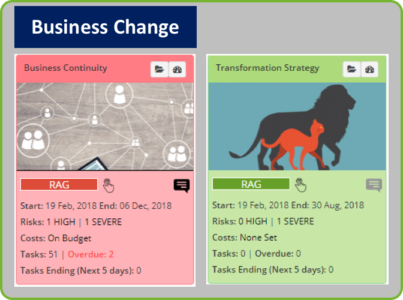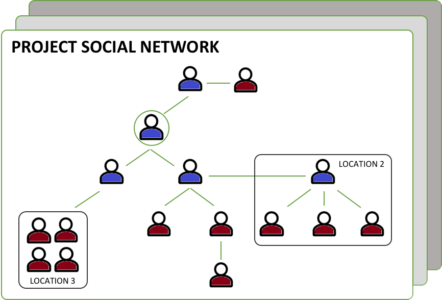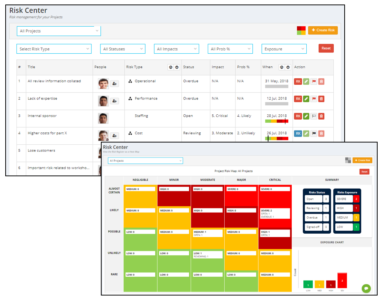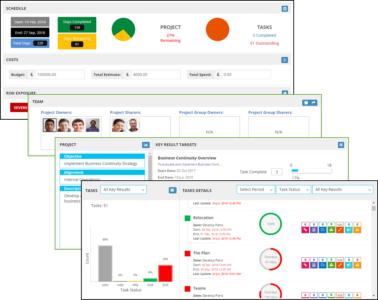OpusView - a new approach to visualising work?
I’m pretty cynical about Project Management tools. I can remember assessing one of the very first ones for my bank – as far as I could see, it was designed to allow people (“if they wanted to”) to disguise a badly managed and failing project by producing plausible and attractive charts and PowerPoint slides that could pull the wool over the eyes of the project’s business stakeholders. Some of the tools which followed even included Collaboration features but most collaboration initiatives are based on a “provide and pray” approach and, as a consequence, most seem to fail.
I’ve already published my general view of Collaboration. It’s a very good idea and it can be an integral part of effective business process development and integration, for a Mutable Business – but the barriers are much more to do with culture than technology.
OpusView, a new class of tool?
Still, as I also said (op. cit.), although culture and business vision come first, tools are still important in order to facilitate cultural change and make it “sticky”.
So, I was interested when Emily Cox of XeauSoft (which I last met some time ago, associated with Jama Software and Requirements Management) pointed me at a new tool – OpusView from IdeasCast – which purports to facilitate the collaborative development of business outcomes, and which XeauSoft is assisting with.
I have been looking at it, in the context of the evolution of automated business outcomes in the mutable business (although OpusView has a much wider scope than just this).
Talking with IdeasCast’s CEO, Bal Mattu, a few things became clear. OpusView is still actively developing – it has customers, who get business value from it, but it is in a constant state of evolution. XeauSoft says it will never be “finished” – the platform is complete, but new enhancements are continually being considered and prioritised for delivery (usually when a customer asks for them).
It was also clear that Bal had a strong “inner model” for his tool when he started development – talking about enhancements (such as the need for an Audit role), the response was usually “yes, I see where that fits in the product” – and that is reassuring. I see this tool as having a real character of its own, it isn’t just a rag-bag of features.
XeauSoft (now IdeasCast’s EU managing partner) has a strong influence on the product’s evolution these days, based on its extensive experience around marketing Jama. Input from customers is encouraged and responded to; at the same time, Xeau is well aware of the possibility of “feature creep” – sometimes “No” or “Not now” is the right answer.
What is OpusView?
This is quite hard to say – perhaps, to a degree, it really is inventing a new category. It is more than just a collaboration tool, because of its focus on business outcomes; but it also offers richer capabilities than the usual simplistic Gantt chart manipulation that often passes for project management. IdeasCast sees itself as an “Enterprise business social software provider”, which seems reasonable. As well as rich visualisations, it offers team-working features such as mind-mapping, blogging, wikis, sketching, voting, and context capture and maintenance.
Work is still ongoing on naming this possibly new category. As well as “collaborative business outcome facilitator”, I suggested something like “Enabling Social Networking for Successful Project Outcomes”. Now to get these down to 3 words….
Bal, on his LinkedIn page, describes OpusView as “business social software to drive execution, management and project collaboration. Improves utilization, transparency and communication among teams, stakeholders and external partners” which seems about right, but hardly trips off the tongue. Perhaps, it’s a “business outcome facilitator” or “collaborative business outcome facilitator”.
OpusView handles work programs delivering business outcomes, rather than just individual projects, but I don’t feel entirely happy comparing it with heavyweight Project and Portfolio Management tools (such as ChangePoint). These may be effective but I see them as addressing a somewhat different mindset. OpusView is process agnostic; it is fundamentally Agile, but it has no difficulty coping with “iterative Waterfall” when appropriate. It was designed from the ground up, on a SaaS/Subscription model, to land small, to exploit social networking, and to expand to many thousands of seats as it demonstrates its usefulness.
OpusView aims at a rather different kind of customer organisation to its competition, not smaller but perhaps one more in tune with mutable business. Nevertheless, there are plenty of potential customers for the different tools not to bang into each other too much. Its most serious competition (in volume, not effectiveness) probably comes from the fairly unstructured use of a mixture of spreadsheets, word-processing, and MS Project (which I don’t really regard as a “proper” Project Management tool – MS Project Server has to add, for example, Project Workspaces, which are Sharepoint Teamsites, to address some of its limitations).
OpusView’s key concepts include Programs of Projects; and Projects, which are divided into Areas, Workspaces and Elements. Elements, at the bottom end, are lists of Tasks and have Owners and Sharers (the latter have restricted access rights); plus, a set of Tasks that can be assigned a Task Leader. I’m no OpusView practitioner, but the granularity supported by this tool seems good, and there are visualisations of the project structure available.
Another key concept, which may be a true differentiator, is its sophisticated use of Templates – which become reusable repositories for organisational memory. A pre-built Template can be reused as a specific Workspace – thus reducing setup time for new projects and reducing waste. Moreover, a Workspace designed for re-use can be converted to a Template – Templates can thus be used as an enabler for continual process improvement and for the dissemination of “Good Practice”. Templates can be QA’d and distributed in libraries or even an external marketplace. Obviously, this is a very powerful feature, even in the short term (especially as IdeasCast is now distributing QA’d starter Templates with the product).
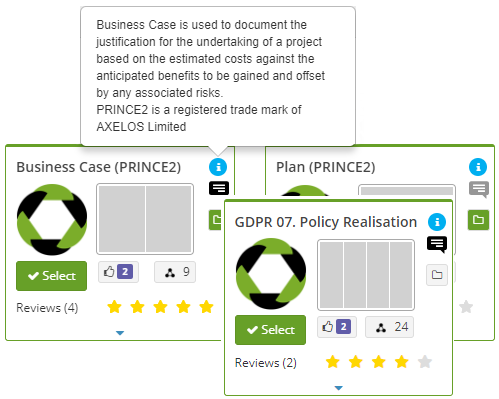
Figure 03 – Its Templates may well be OpusView’s secret sauce. Longer term, it could be a major success factor for building an ecosystem or community bigger than IdeasCast around the product (for IdeasCast, better to be part of a huge and growing pool, than all of a small and static pool). Templates should be seen as embodying corporate memory in an accessible and re-usable form, in my view.
The good, the bad and the ugly
So, what’s good?
This is in no way a proper product review, but I thought I’d pick out some features I particularly liked.
OpusView is sold on a subscription SaaS model, although private cloud and on-premise options are available. This is good. It shares risk between vendor and client, and keeps the vendor on its toes. Everyone involved with OpusView sees it competing with strong established competition by landing small in an organisation and gaining converts through proven success – exactly the approach I’d recommend, and one for which the subscription model is highly appropriate. Xeau has looked at variable “Pay per Usage” models but the purchasing departments in potential customers haven’t been keen. It does need to choose its customers carefully as an immature company with a culture hostile to collaboration (or even innovation) might well fail – and will then blame its tools, possibly in public. Nevertheless, the OpusView user experience I’ve seen looks as if it might overcome such hostility better than some more established tools can.
Most importantly, I think that OpusView supports “choice” rather than forcing people into specific “best practices”, which are always rather subjective. The provision of appropriate “good practice” templates can be used, by the OpusView customer, to nudge people into desired behaviours. For instance, both Scrum and Prince2 are supported. I’d prefer Scrum, but sometimes Prince2 is a better choice (or externally mandated) – the customer needs to be responsible for making its own choices.
I was very pleased to see that OpusView supports a strong role structure – owners, sharers and, soon, auditors – with granular access controls. There is a “sharing map”, which lets you visualise users, collectives and permissions in the context of the shared network.
I was also pleased to see provision for managed access by third parties. With a collaborative culture in operation, effective (but light touch) management, facilitation and oversight of roles, access and communications are essential. I can see third party, experienced mentors helping to achieve the cultural change that I see as being necessary when introducing something like OpusView.
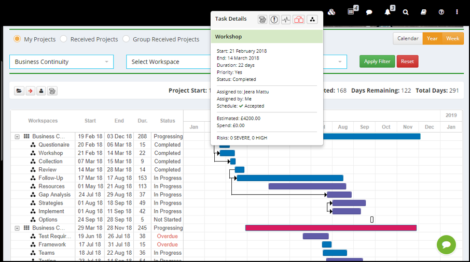
Figure 04 – There is more to managing projects than Gantt charts, but OpusView does offer integrated Gantt charting
OpusView does have integrated Gantt charting, of course, but what I especially like is that these charts are generated from what is in the tool, not used as an input. This should make it harder to game the system and produce charts that hide impending problems. It doesn’t yet support Critical Path Analysis, which I think is a pity, but Bal says that customers aren’t asking for this, so it isn’t a high priority, although it will come sometime.
It also seems to handle Risk well, and help with its visibility and communication. I was pleased to see that it doesn’t assume that mitigation is always 100% effective – it recognises “residual risk”.
I liked OpusView’s Project Board concept, which implements a social connection between people and projects. The Project Board seems to centralise everything about a project and is the home of discussions within the project. It can be “published” and, in association with integrated Blogs and Wikis, helps to achieve buy-in across the whole organisation. I think that OpusView Work Center, which will manage people and their workload allocation, and is promised for v2.0, will be a welcome and complementary addition to this. I also note that people have already built templates for what are, in effect, CRM systems in OpusView, indicative of its ability to manage the people aspects of projects.
OpusView does have a useful “Cost of work” management feature. This supports both individual and team-based costs, maintains revision history and supports export to Excel. Work Center, coming in v2, will add management of peoples’ workloads.
There is a Project Editor, “Studio”, which helps people to define their solution, reframe ideas and plan project outcomes. Workflows can be visualised and team-working coordinated through Studio.
It is possible to export a project as a usable and readable Word document. This is obviously useful, although it doesn’t really go far enough – but APIs and integration platforms are on the immediate end of the product roadmap (see next section).
Finally, under “what’s good”, IdeasCast is engaging with academic experts, including members of Coventry University, UK and Rajasthan University, India, in social networking and user experience design. All too often, these aspects are left to IT professionals, who often lack the mindset needed to do this well. I remember the early Microsoft usability testing, where the Windows developers complained that a better class of end-user tester was needed, one that understood how Windows technology was built.
What’s bad?
OpusView presumably already matches the needs of its early adopters but, in order to be a leader in the collaborative and social-networking space it is targeting, it needs to deliver some of the features on its roadmap. I have no reason to believe that it isn’t in the process of doing this. I was told to expect v2.0 (current version is 1.5) early in October 2018, and this covers the majority of the “what’s bad” issues I see. The shipping of additional templates (which will further reduce barriers to adoption) is anticipated in v2.0.
Looking at the “Now” section of its roadmap, I see screen sharing (essential for a collaboration-based tool, I’d think, before clumsy or dysfunctional 3rd party “free” tools are adopted). Similarly, “sentiment analysis” is coming – really important for effective management of collaborative interactions, in my opinion.
I also see the provision of an API on the list. Please! Because, if this tool is being introduced with “start small and grow with success”, it needs to be able to co-exist with other tools and somewhat incompatible processes, and an API will really help. Integration is also on the Now Roadmap and – very sensibly, in my opinion – IdeasCast is going to partner with market-leading integration platforms, rather than trying to build everything itself. The API is promised for v2.0 and, initially, this will support the light-weight Zapier integration platform; more sophisticated integrations will follow.
Single sign-on (SSO) support, so that its roles and users are consistent with corporate roles and access controls, is promised soon (good). IdeasCast, however, is waiting until it has a customer with an SSO need to complete this with, which probably makes sense, as not everyone will see the need for SSO, and its requirements are somewhat different in on-premises and Cloud environments anyway.
One omission I noted from its Cost of Work facility was an Estimation tool. Estimation is non-trivial and should be based on scientific principles, not politically-influenced guestimates (a “guess” is not the same as an “estimate”; and a “guestimate” pretends to be an estimate but has little to support it). A cost or resource estimate should be the median of an uncertainty range; as the project proceeds, the uncertainty decreases until it reaches zero on delivery. Making and justifying estimates, and managing the fall in uncertainty (if the uncertainty increases, this is an early indicator of a project in trouble) isn’t trivial – it is an area which could benefit from good tooling.
Several feature enhancements are scheduled and seem well-chosen. The roles will be expanded to include a more complete “read view role” – audit role – than can be achieved just by restricting a sharer role.
The skills catalogue is being enhanced with annotations and attachments, which should address Bal’s vision of OpusView projects being advertised in-house, with potential participants applying to join a project that is missing their particular skills. This is an excellent way to encourage buy-in across an organisation, but will need review (QA of skills) and managing (identification of, say, useful people who are too busy to take part).
Bal also seems keen on a “morale management” template I suggested – contrary to much management opinion, apparently, morale has to be encouraged and managed, not just taken for granted.
It will also be possible to reschedule groups of tasks in one go (which will help with keeping the OpusView models in line with the real world) and the costing facilities will be enhanced (with cost-of-goods as well as cost-of-people).
Under “Next”, the roadmap includes enhancements such as voice recording and SMS notifications. I would also like to see an independent community arise around OpusView, with an active marketplace in templates.
Under “Later”, more significant efforts such as Video Conferencing are included. Video conferencing will be invaluable if done well; but doing it well is non-trivial. I also see applications for machine learning and augmented intelligence – in the selection of templates, their QA and the identification and rationalisation of duplicate templates, perhaps.
As long as the “Now” parts of the roadmap don’t slip, I don’t see that OpusView has any serious shortcomings at the moment. The Roadmap also confirms that OpusView will be developed usefully, on into the future. The Roadmap is not set in stone, of course, and I am assured that IdeasCast wants to set up a Customer Advisory Board, to help validate the product Roadmap and drive it forward – a very good idea, and preferably sooner rather than later.
What’s ugly?
Ugly? OpusView is really rather an attractive product to work with.
Yes, but there is an “ugly” fact to deal with too – OpusView focuses on achieving effective business outcomes rather than just technology implementation and this requires a certain degree of organisational maturity. It is indicative that customer pressure for further enhancing the “audit role”, for example, is coming from people that want to address CMMI maturity modelling around OpusView.
There are plenty of “antipatterns” where maturity initiatives are used to justify inertia and over-documentation, but I believe that maturity initiatives can be managed in a productive and agile way (although details of how are out-of-scope for this blog). In fact, I believe that the successful mutable business will always (whether or not it engages with formal certification initiatives) be the sort of business that says what it’ll do, does it and then analyses the gaps between actuality and expectation – so it can do better next time. And, a focus on continual and measured improvement is a key indicator for what I mean by maturity.
So, to get full value out of something like OpusView, I think that a business has, at least, to be on a journey towards a maturity culture. It needs to embrace constant evolution in response to changing customer expectations. OpusView is not just for IT professionals collaborating on technical projects. It has applications throughout the mutable business and, considering this, helping mutable businesses to be more agile may be its “sweet spot” for delivering value.
Unfortunately, although OpusView can enable and facilitate cultural change, as with any software, it can’t make your culture change for you. The ugly truth is that customers seeking the best value out of OpusView will need to be prepared to put some resources into getting their cultural house in order. The good thing about this is that a responsive maturity culture will bring benefits far beyond just making OpusView work well – so customers who manage the evolution of their cultural maturity well could get even more out of OpusView than they initially expected.

